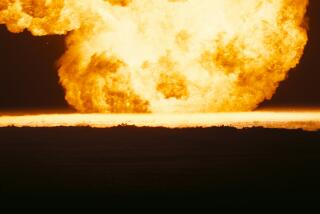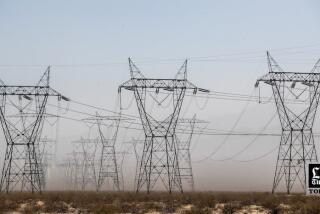Tests Duplicate Fusion Process, Texans Assert
- Share via
Scientists at Texas A&M; University believe they have confirmed the most controversial part of a proclaimed breakthrough in nuclear fusion that ignited the world of science when it was announced two weeks ago at the University of Utah.
The Texas A&M; team, which began trying to duplicate the Utah experiment as soon as it was announced, has succeeded in producing more energy from a simple table-top apparatus than it takes to run the experiment, a university spokesman said Sunday.
A press briefing was scheduled for this morning at College Station, Tex., at which time details of the experiment are to be disclosed.
“Our fellows believe they have duplicated and confirmed the Utah fusion process,” university spokesman Edward Walraven told The Times in a telephone interview. “They are convinced everything is going to hold up.”
Feverish Attempts
At least a dozen major laboratories in this country, as well as many other labs around the world, have been working feverishly for the last two weeks in an effort to duplicate the work of B. Stanley Pons of the University of Utah and Milton Fleischmann of the University of Southhampton, England.
The two electrochemists claimed to have produced energy from nuclear fusion at room temperature, and they said they got far more energy out of their simple experiment than it took to run it.
That would mean the two men had achieved what no one else in the world has been able to do--get more energy out of their fusion experiment than they put in, despite the fact that many billions of dollars have been spent on complex fusion reactors that are designed to produce temperatures greater than the core of the sun.
Until Pons and Fleischmann came along, nearly all the experts thought energy from nuclear fusion was possible only with such high temperature devices, which have required far more energy to run than they have produced.
Fusion occurs when the nucleii of two atoms--in this case a form of hydrogen called deuterium--merge in a process that releases energy. Scientists have long dreamed of using fusion to generate energy on a grand scale because it promises to end the planet’s energy woes.
Fuel for fusion could come from sea water, a virtually inexhaustible source, and fusion is not expected to yield the dangerous radioactive products emitted by the current generation of nuclear power plants, which split atoms, rather than fuse them, to produce energy.
Acclaim and Skepticism
Thus the Utah announcement was greated with acclaim by fusion buffs, and considerable skepticism by scientists who have been burned in the past by false claims of fusion breakthroughs.
Although several other laboratories have reported evidence that seems to confirm that Pons and Fleischmann were in fact getting some form of nuclear fusion, as evidenced by the emission of neutrons which would be produced in the fusion reaction, no one until Sunday had claimed to have derived more energy than they put in.
It is no understatement to say that Pons and Fleischmann turned the world of energy research upside down with their claims to have produced energy with such a simple device, and most experts have remained skeptical.
The Texas A&M; results will make that skepticism a bit more difficult to maintain, because the Texas institution is extremely well respected in the field of electrochemistry.
From the beginning, skepticism was not the order of the day at Texas A&M.; Electrochemist Charles R. Martin has known both Pons and Fleischmann for years and he told The Times the day after the Utah experiment was announced that he considered them “brilliant men.” He knew so little about how the experiment was conducted, however, that he asked that a copy of a Times article, which detailed what was then known about the experiment, be sent to his office.
With that report in front of him, Martin and a team of respected experts set out to duplicate the Utah experiment.
Martin could not be reached Sunday night, but earlier in the day he told United Press International that his team had succeeded in producing more energy, in the form of heat, than it took to run the experiment.
But was it produced by fusion?
Many experts believe that when the final chapter is written on this scientific drama, the energy produced by Pons and Fleischmann will be found to be the product of a very slow nuclear fusion process, and some mysterious kind of chemical reaction, although no one so far has been able to explain what that could be.
Members of the Texas team are also having trouble deciding just what they have on their hands.
“We cannot at this time completely dismiss the possibility of some unusual chemical reaction,” Martin told UPI. “That’s a remote possibility, though.”
‘Do Not Prove Fusion’
That reservation was echoed by Michael Hall, head of the Texas A&M; chemistry department, who told the wire service: “We’re not sure what is going on yet. Our measurements do not prove it is fusion yet.”
He insisted, however, that the Texas experiments produced more energy than they consumed, which would represent a major milestone in the effort to duplicate the Utah research.
“We have confirmed the most important part of their observations, which is excess heat (energy) generation,” Hall told UPI.
By Sunday night, both men had retreated to their laboratories to prepare for today’s formal announcement and were not taking phone calls.
If the Texas team has, indeed, confirmed the Utah claim, it will mean a major new door has been opened into the world of energy research. But many questions will undoubtedly be raised today.






